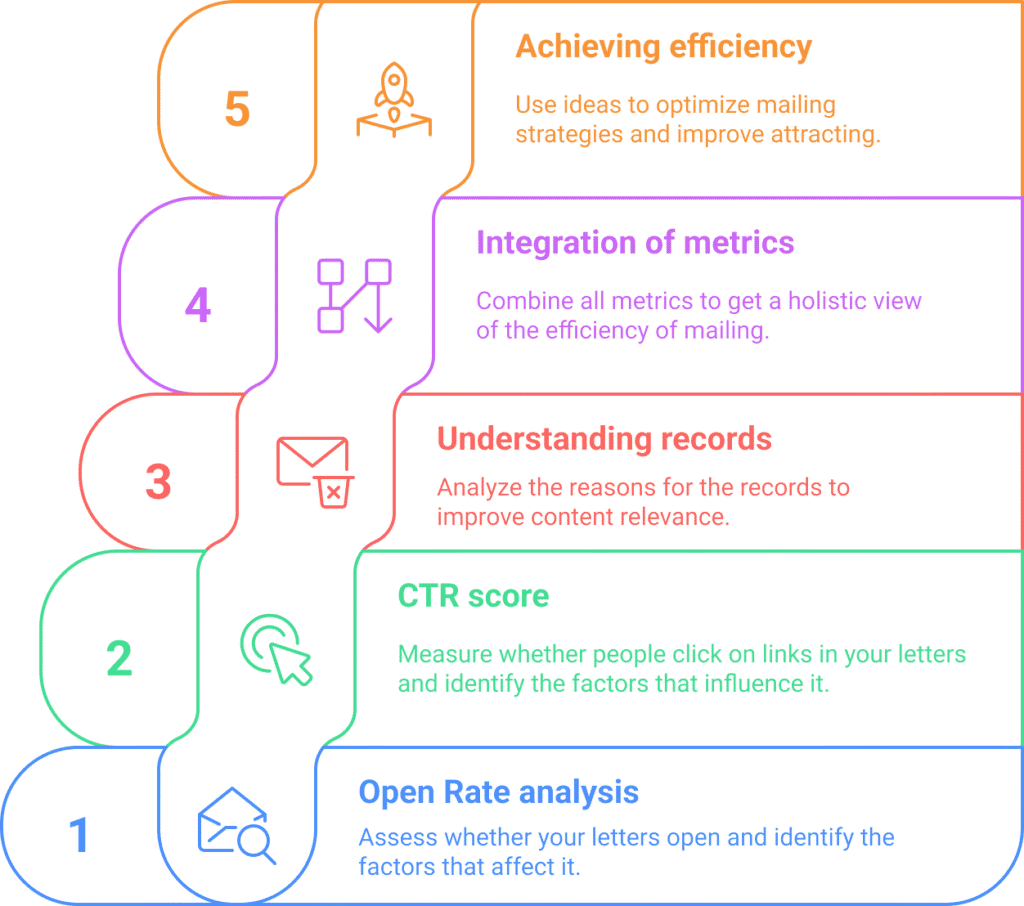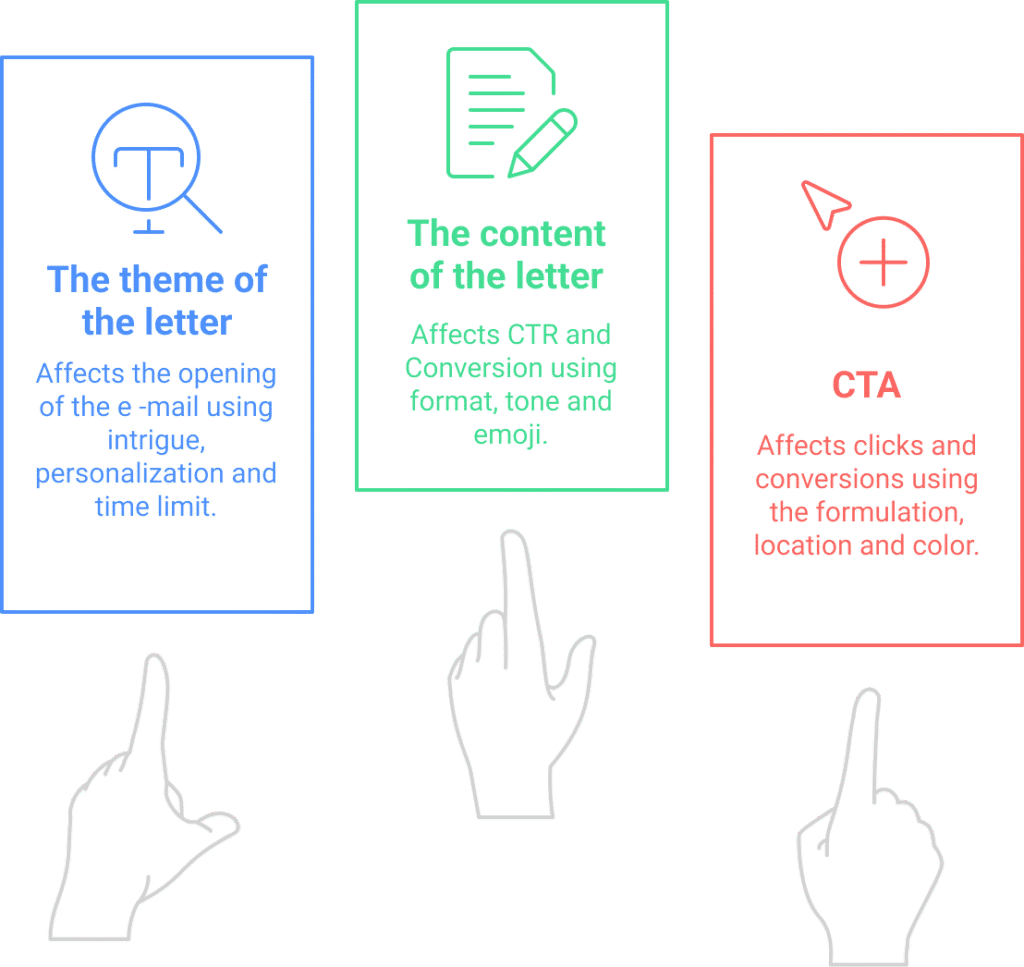How to analyze the effectiveness of email newsletters: key indicators and mistakes

- Opens, clicks, unsubscribes — what really matters
- Key performance metrics
- Open Rate: Are your emails being opened?
- Click-Through Rate (CTR): Are people clicking on the link?
- Unsubscribe Rate: why do people unsubscribe?
- What metrics really matter?
- How to work with analytics in mailing services
- What data can be obtained from mailing services?
- How to use analytics to improve your newsletters
- How to automate analysis?
- Testing the theme, content, CTA
- What is A/B testing and why is it needed?
- How to test email subjects?
- How to test the content of an email?
- How to test CTA (Call-to-Action)?
- How to properly conduct A/B testing?
- How not to “drain” a good database due to incorrect analysis
- Ignoring segmentation during analysis
- Excessive attention to Open Rate without analyzing other indicators
- How to avoid this error?
- Lack of testing different content options
- Ignoring spam complaints and unsubscribes
- Using an outdated database
1. Opens, clicks, unsubscribes — what really matters
When you launch an email campaign, the first question that comes to mind after sending it is “How did it work?” But evaluating the effectiveness of your email campaign is not just about looking at open rates or clicks. You need to understand which metrics really matter and how they can help you improve your strategy.

Key performance metrics
There are three main metrics that are most often analyzed in email marketing:
- Open Rate (OR) — percentage of openings
- Click-Through Rate (CTR) — percentage of clicks
- Unsubscribe Rate — percentage of unsubscribes
Each of them has its own role in the overall assessment of the effectiveness of the mailing, but it is important to look not only at individual numbers, but also at their relationships.
Open Rate: Are your emails being opened?
Open Rate is the percentage of people who opened your email out of the total number of people who received it. Its formula is:
Open Rate = (Number of opens / Number of emails delivered) * 100
A high Open Rate indicates that people were interested in the subject of the email and wanted to see what was inside. But that doesn’t mean they took the action you wanted them to take — clicked on the link or bought the product.
What affects Open Rate?
- Subject line : If the subject line is uninteresting or too promotional, people simply won’t open the email.
- Sender’s name . People trust real names more than faceless “Mailings from XXX Company.”
- Sending time : If you send an email at an inappropriate time (for example, at night or on a weekend), the chance of it being opened decreases.
- Base cleanliness . If you have many inactive subscribers, the Open Rate will be low, even if the subject of the email is good.
Example: You notice that your Open Rate is only 10%, while in previous mailings it was 25%. You check the topic – it is too general, does not contain intrigue. You do an A/B test with other variations of the topic, and the Open Rate increases to 22%. Conclusion? Your audience responds to a more specific and personalized topic.
Click-Through Rate (CTR): Are people clicking on the link?
CTR is the percentage of people who clicked on a link in an email after opening it. Formula:
Click-Through Rate = (Number of clicks / Number of opens) * 100
This indicator is more important than Open Rate because it shows how much the content of the email and the CTA (Call-To-Action) motivate people to take the desired action.
What affects CTR?
- Content of the letter : Does it clearly explain the value of your offer?
- Call to action (CTA) – Is it clear what needs to be done? Is the button with the link prominent enough?
- Relevance of content to topic . If the topic promises one thing, but the email contains something completely different, the CTR will be low.
Example: You sent an email with the topic “How to Get a Free SEO Checklist.” You provided a link to the article in the email, but didn’t mention the checklist anywhere. As a result, the CTR was low — people didn’t find what they were expecting.
Unsubscribe Rate: why do people unsubscribe?
The unsubscribe rate shows how well your newsletter meets your subscribers’ expectations.
Unsubscribe Rate = (Number of unsubscribes / Number of emails delivered) * 100
If it exceeds 0.5–1%, you should think about what you are doing wrong.
Main reasons for unsubscribes:
- You are sending too many emails.
- The content doesn’t match what people expected.
- The emails look like spam or intrusive advertising.
- There is no value for the subscriber.
Example: You notice that more people are unsubscribing after each of your newsletters than usual. You check the content and see that recently the newsletter has become too commercial – you are constantly trying to sell something. By striking a balance between useful content and promotions, you reduce the unsubscribe rate.
What metrics really matter?
Marketers often make the mistake of focusing only on Open Rate or CTR. However, it’s important to look at the whole picture:
- If you have a high Open Rate but a low CTR, the problem is in the content of the email or in the call to action.
- If the Open Rate is low, the problem is in the subject of the email or the time of sending.
- If the number of unsubscribes is growing, you need to review the frequency and content of your newsletters.
The main rule: analyze not individual metrics, but their interaction. For example, if you have an Open Rate of 30%, a CTR of 10%, and an unsubscribe rate of 0.2%, that’s a great result. But if, with the same Open Rate, the CTR drops to 2% and the unsubscribe rate increases to 1%, something needs to be changed.
Let’s summarize
Understanding the key email marketing metrics is key to effective email campaigns. Open Rate, CTR, and Unsubscribe Rate work together to help you measure the effectiveness of your campaigns. But when analyzing metrics, it’s important to consider the context: who your audience is, how they interact with your emails, and what their expectations are.
Focus not only on dry numbers, but also on subscriber behavior. Test different approaches, analyze the results, and you will be able to create newsletters that do not just “open and close”, but actually work.
2. How to work with analytics in mailing services
To analyze the effectiveness of your email campaigns, you need access to detailed analytics. Most popular email marketing services, such as Mailchimp, SendPulse, GetResponse, HubSpot, or Klaviyo, have built-in analytics tools. But simply viewing metrics is not enough — you need to understand how to interpret them correctly and what conclusions to draw from them.

What data can be obtained from mailing services?
After launching a campaign, you will receive a wealth of information about your followers’ behavior. Key data to analyze:
- Delivery Rate — how many emails actually made it into mailboxes.
- Open Rate — how many people opened the email.
- Clicks (Click-Through Rate, CTR) — what percentage of users clicked on the link in the email.
- Conversion Rate — how many people completed the target action after transitioning (purchased a product, registered, etc.).
- Unsubscribe Rate — how many people decided not to receive your emails anymore.
- Spam Complaint Rate — the percentage of people who marked your email as spam.
Each of these metrics helps you identify what is working well and what needs improvement.
How to use analytics to improve your newsletters
1. Analyze delivery rate
If your emails don’t reach your subscribers, they’ll never open them or click on the link. The ideal Delivery Rate should be above 95% . If it’s lower, you need to figure out why:
- You have many invalid addresses (check the database and delete inactive contacts).
- Your emails are going to spam (check the headers and sender).
- Recipients’ mail is blocking you due to a high level of spam complaints.
What to do?
- Use double opt-in when registering subscribers (so they confirm their email).
- Regularly clean the database of “dead” addresses.
- Follow the guidelines for avoiding spam (don’t use words like “free,” “discount,” “urgent”).
2. Analyze Open Rate and Test Email Subjects
If your Open Rate is low (less than 15-20% ), it means that:
- The subject of the letter did not interest the subscribers.
- The sending time is incorrect.
- Your database is of poor quality (people simply don’t remember what they signed up for).
What to do?
- Do A/B testing of email topics: divide your audience into two parts and send them emails with different topics. Analyze which one worked better.
- Use personalization in the subject: “Olexander, your personal bonus is inside!”.
- Send emails at the best time (for B2B – weekday morning, for B2C – evening or weekend).
Example:
You have an Open Rate of 10% and you decide to test a new topic. The first group receives the topic “Our new SMM course – register now!” , the second group – “How to become an SMM expert in 30 days? Find out here” . The second topic has an Open Rate of 22%. Conclusion? Question formulation and intrigue work better.
3. Analyze CTR and content quality
If people open the email but don’t click on the link, the problem is in the content or placement of the CTA button.
What to do?
- Highlight the CTA button so that it is visible.
- Use a call to action: “Download for free”, “Go to article”, “Get a discount”.
- Make the content clear and useful – without unnecessary text.
Example:You sent an email with a “Click here” button, but the CTR is very low (2%). You change the CTA to “Get a bonus” – the CTR increases to 7%.
4. Identify reasons for unsubscribes
If your Unsubscribe Rate exceeds 0.5-1% , something is wrong.
Why do people unsubscribe?
- You are sending too many emails.
- The content does not meet their expectations.
- They don’t remember signing up for your newsletter.
What to do?
- Add the ability to choose the frequency of the newsletter (once a week, once a month).
- Ask people why they unsubscribe to understand the reasons.
- Segment the base and send relevant content.
Example:You were sending emails 3 times a week, and the Unsubscribe Rate increased to 2%. You decide to send 1 email per week and add more useful content. After a month, the Unsubscribe Rate drops to 0.3%.
How to automate analysis?
Many email marketing services offer built-in analytics and automation tools.
- Mailchimp — analyzes user behavior and makes predictions about the best sending time.
- GetResponse — has a visual analytics dashboard with key metrics.
- HubSpot — allows you to track the user’s journey after a click in detail.
What to do?
- Use Google Analytics UTM tags to track traffic from your newsletter.
- Integrate your email service with CRM to see the full customer interaction cycle.
- Create reports comparing different mailings to identify trends.
Let’s summarize
Competent work with analytics allows you not only to evaluate the success of campaigns, but also to improve them. If you see that the Open Rate is low, change the subject of the email, if the CTR is bad, improve the content and CTA. Constant analysis and testing will help you create effective email campaigns that really work and bring results.
3. Testing the theme, content, CTA
Email marketing is not just about writing emails, it’s also about continuous testing. Even the best strategy can yield poor results if you don’t experiment with email subjects, copy, and calls to action. In this section, we’ll look at how to properly test, what metrics to analyze, and what mistakes to avoid.

What is A/B testing and why is it needed?
A/B testing (split testing) is a way to compare two or more versions of the same element to see which one performs better. In the case of email campaigns, you can test:
✅ Subject line — affects Open Rate.
✅ Text — affects CTR and conversions.
✅ CTA button — affects the number of clicks.
✅ Graphics — changes visual perception.
✅ Sending time — affects audience activity.
Example:You have an Open Rate of only 12%, and you decide to test two topics:
- “🔥 Limited time 50% discount — 24 hours only!”
- “Your personal discount is 50%! Valid only today!”After testing, it turns out that the first option gave an 18% Open Rate, and the second – 14%. So, it is worth using the first type of headlines in the future.
How to test email subjects?
1. Use intrigue or specificity
The subject line is the first thing a user sees in their email. It should be either intriguing or clear and understandable.
Example:❌ “Discount on a new product” → ✔️ “Olexandr, you get a 30% discount on a new product!”❌ “New business opportunities” → ✔️ “How can your business earn +30% in 2024?”
2. Personalize the theme
Using a customer’s name, city, or past experience can significantly increase Open Rate.
Example:❌ “Marketing Tips” → ✔️ “Mary, improve your marketing in 5 minutes!”
3. Add time limits
People respond better to emails that contain a clear deadline.
Example:❌ “Just a new product” → ✔️ “Only 24 hours: 50% off the advertising course!”
4. Test the topic length
Too long topics do not display completely in mobile clients. The optimal length is 4-7 words.
How to test the content of an email?
Even if a person opens an email, it doesn’t mean they’ll read it to the end or click on the CTA. That’s why it’s important to experiment with your copy.
1. Submission format
Some people respond better to structured text (lists, short paragraphs), while others respond better to a narrative style.
Example of an A/B test:
- Option A: A clear list of product benefits.
- Option B: A successful customer story with the same product.
After the test, we find out which format gave more clicks.
2. Tone and style
One audience is more suited to a formal tone, while another is more suited to an informal, friendly style.
Example:
- Formal: “Dear Alexander, we invite you to familiarize yourself with our new services.”
- Friendly: “Olexander, we have something super new for you! Look what we came up with!”.
3. Using emojis
Sometimes emojis can make a letter more emotional, but if there are too many of them, it’s annoying.
Example:
- Option A: “🔥 Only 24 hours: a great deal for you!”
- Option B: “Only 24 hours: a great deal for you!”
If the emoji variant received a higher CTR, it is worth using them in the future.
How to test CTA (Call-to-Action)?
The CTA button is the main element of conversion. If the user opened the email but did not click on the button, it means that the CTA is ineffective.
1. CTA wording
The call to action should be specific and clearly explain what the user will get.
Example:❌ “Click here” → ✔️ “Get 50% off”❌ “Learn more” → ✔️ “View course now”
2. CTA placement
The CTA should not be lost in the text — it should be highlighted and preferably in several places in the letter.
Example test:
- Option A: CTA only at the bottom of the letter.
- Option B: CTAs in the middle and at the end.
Based on the test results, you can determine which option brings in more clicks.
3. CTA button color and size
The color of a button affects its visibility. For example, red and orange buttons typically have a higher CTR than gray or white buttons.
Example test:
- Option A: Green button “Get bonus”.
- Option B: Red button “Get bonus”.
If one of them gives a higher CTR, it is worth using that particular color.
How to properly conduct A/B testing?
For the test to be correct, you must follow several rules:
1️⃣ Test only one parameter . If you change the theme, content, and CTA at the same time, you won’t know what exactly affected the results.
2️⃣ Divide the audience in half . Half get one option, half get the other.
3️⃣ Collect enough data . If you have 1000 followers, a test on 10 people will not give a reliable result.
4️⃣ Track results . Analyze Open Rate, CTR, and conversions to understand which option is better.
Let’s summarize
A/B testing is the key to success in email marketing. A well-chosen subject line increases open rates, engaging content increases email viewing time, and an effective CTA compels people to take action. If you regularly test your email campaigns, you get more results for the same cost.
4. How not to “drain” a good database due to incorrect analysis
Building a quality email database is only half the battle. The second, no less important part is working with analytics correctly so as not to lose subscriber trust and reduce the effectiveness of your mailings. Many companies misjudge campaign results or misinterpret data, which leads to subscriber loss, lower Open Rates, and increased spam complaints.
In this section, we will look at the most common mistakes in analyzing email campaigns and how to avoid them.
1. Ignoring segmentation during analysis
One of the biggest mistakes is to evaluate an email campaign as a whole, without taking segmentation into account. If you sent an email to your entire base and got an average Open Rate of 20%, it doesn’t mean that it worked equally well for everyone.
What does this look like in practice?
🔴 Mistake: You analyze the indicators of the entire database together.
🟢 The correct approach: You divide the database into segments (new subscribers, regular customers, those who have not opened emails for a long time) and evaluate the effectiveness for each of them.
Example:An email about discounts on sports equipment received a 25% Open Rate. But after segmentation, it turned out that among athletes this figure was 40%, and among those interested in electronics – only 5%. So, the problem is not in the email, but in the irrelevant audience.
How to avoid this error?
✅ Always analyze the effectiveness of your mailings by segment.
✅ Separate active and inactive subscribers.
✅ Test personalized mailings for different groups.
2. Excessive attention to Open Rate without analyzing other indicators
The percentage of emails opened (Open Rate) is an important indicator, but by itself it does not indicate the real effectiveness of the mailing.
What does this look like in practice?
🔴 Mistake: You are happy that the Open Rate has increased from 15% to 25%, but you do not see that the number of clicks has remained low.
🟢 The right approach: You evaluate the entire funnel: Open Rate, CTR, conversions, unsubscribes, time of interaction with the email.
Example:The subject line “Your parcel is lost. Open it urgently!” gave a 40% Open Rate, but a CTR of only 2%, because after opening it, people found nothing valuable.
How to avoid this error?
✅ See not only Open Rate, but also CTR (Click-Through Rate).
✅ Analyze the viewing time of the email – if people open but close it after 2 seconds, the topic was clickbait.
✅ Track real conversions – did subscribers take the target action?
3. Lack of testing different content options
Email marketing is about constant experimentation. If you don’t test different content variations, you’ll just assume what works best.
What does this look like in practice?
🔴 Mistake: You send the same email format and don’t analyze what can be improved.
🟢 The right approach: You test email subjects, CTAs, content format, and track what gives the best results.
Example:You test two CTA options: “Get a bonus” and “Learn more.” After the test, it turns out that the first option received 2 times more clicks.
How to avoid this error?
✅ Conduct A/B tests regularly.
✅ Analyze audience behavior — what they read, what they click on.
✅ Experiment with formats (video, images, text emails).
4. Ignoring spam complaints and unsubscribes
If your emails end up in spam or many people unsubscribe, it’s a signal that something is wrong with the mailing list.
What does this look like in practice?
🔴 Mistake: You don’t analyze the reasons for unsubscribes and don’t change your approach.
🟢 Correct approach: You track the dynamics of unsubscribes, analyze which emails cause a negative reaction, and adjust your strategy.
Example:After sending an email with the subject “Olexander, you only have 1 hour!” the number of replies increased by 2 times. Analysis showed that people perceived this email as manipulation.
How to avoid this error?
✅ Track unsubscribes after each email.
✅ Ask for the reason for the unsubscribe (in the form after clicking the “Unsubscribe” button).
✅ Avoid aggressive and manipulative topics.
5. Using an outdated database
Your email database is getting old, and if you don’t regularly clean it of inactive contacts, it reduces the effectiveness of your mailings.
What does this look like in practice?
🔴 Mistake: You keep sending emails to people who haven’t opened them in a year.
🟢 The right approach: You regularly clean your database of inactive contacts and work on resuscitating subscribers.
Example:You notice that 30% of your base hasn’t opened your emails in the last 6 months. You create a reactivation campaign with the theme “We miss you! Here’s a bonus to get you back” and get 15% reactivations.
How to avoid this error?
✅ Regularly clean the database of “dead” subscribers.
✅ Use resuscitation campaigns for inactive ones.
✅ Send emails only to those who are really interested in your content.
Let’s summarize
Incorrect analysis of email campaigns can destroy even the best subscriber base. It is important not to just look at the numbers, but to understand what is behind each indicator. The main rules of effective analysis:
✔️ Always consider audience segmentation.
✔️ Look at the entire funnel: Open Rate, CTR, conversions.
✔️ Conduct A/B testing and look for the best content options.
✔️ Track spam complaints and the number of unsubscribes.
✔️ Regularly clean the database and work with inactive subscribers.
If you analyze your mailings correctly, your email base will grow and your campaign results will improve! 🚀



